Impact
We are confident that Cool Innovation's efforts can significantly contribute to the world in three key areas: reducing food loss, achieving the SDGs, and enhancing the economy.

The global issue of food shortages is not due to insufficient production but primarily due to significant food loss. According to FAO research, food loss and waste are estimated for each segment:
Production: Losses due to mechanical damage and spillage during harvest operations (e.g., threshing, fruit picking), and crops sorted out post-harvest.
Post-Harvest: Losses due to spillage and degradation during handling, storage, and transportation between the farm and distribution.
Processing: Losses during sorting, washing, peeling, slicing, boiling, processing interruptions, and industrial processing.
Distribution: Losses and waste in market systems such as wholesale markets, supermarkets, retail stores, and wet markets.
Consumption: Losses and waste at the household level during consumption.
The situation for root vegetables and fresh produce is particularly severe, with average losses of 57% and 63.29%, respectively.
When excluding losses from agricultural production and consumption, post-harvest, processing, and logistics account for 32.43% and 33.57%, respectively, indicating an inadequate supply chain infrastructure.
The WWF-UK report "Driven to Waste: The Global Impact of Food Loss and Waste on Farms" estimates that global food waste on farms reaches 1.2 billion tons annually, valued at $370 billion. Fruits and vegetables make up 26% of the total production (in tons) but account for 43% or $160 billion in economic value.
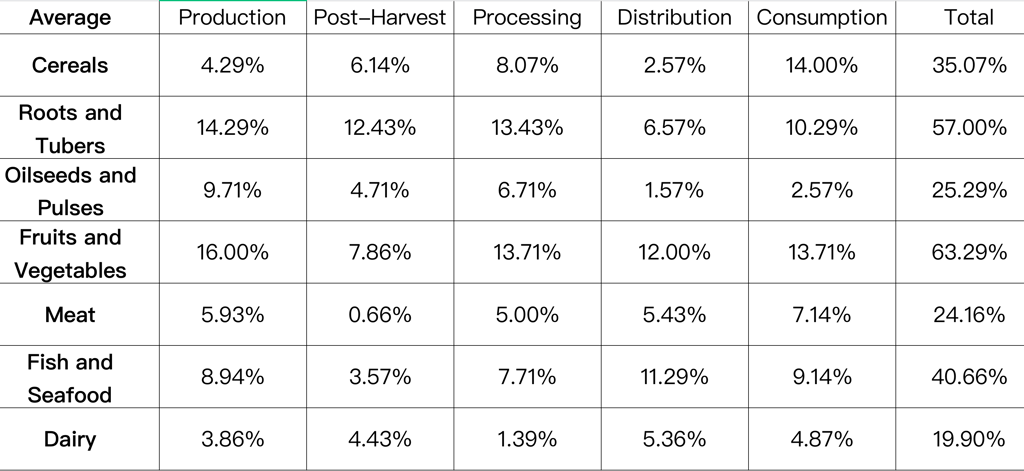

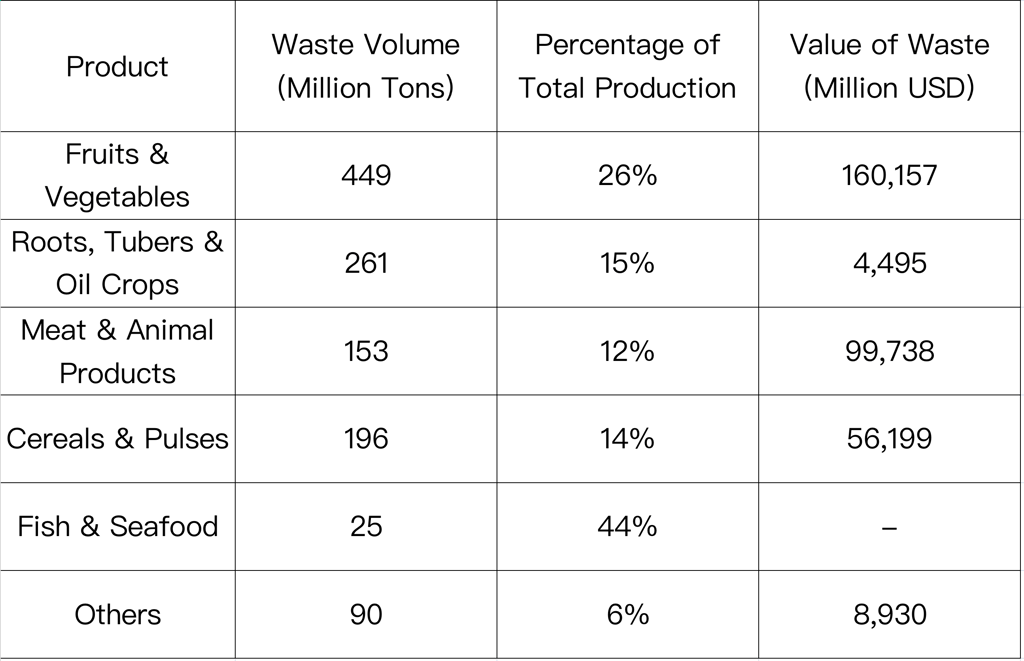

However, these waste values are based on farm gate prices and do not include the losses or added value in the supply chain. It is crucial to highlight the price spread between farm gate prices and consumer prices.
These price spreads reflect various costs involved in transporting, processing, distributing, and marketing agricultural products from farm to consumer. The price spread can vary significantly depending on factors such as product type, distance traveled, seasonality, and market demand.
Tracking price spreads helps analyze the efficiency and competitiveness of the agricultural supply chain and provides insights into the overall structure of agricultural markets. According to the USDA Economic Research Service (ERS), the price spreads for various fresh products are shown in the table below.
Based on the above data, market values range from 3.11 times to 6.84 times. Applying these price spreads to the $160 billion loss of fruits and vegetables results in a potential value of $497.6 billion to $1.0944 trillion.
Considering the economic impact on the entire food-related industry, this represents a business opportunity exceeding $1 trillion, where our services can make a significant contribution.
For example, the Philippines aims for agricultural self-sufficiency, but food loss exceeds 40%. Reducing this loss by half would effectively increase production by 20%. In our case study in the Philippines, we transported 1.5 tons of 18 different vegetables over 19 days from Benguet to Manila and then to Palawan. Typically, Filipino food traders conduct such transportation once or twice a week with a minimum loss rate of 40%, and upon arrival in Palawan, only Class B quality remains.
Using our products, we reduced the loss rate to one-tenth, at 4.5%. In a single transport, this saved $2,100 in costs due to loss reduction, and most of the produce could be sold as Class A to restaurants and hotels (previously, Class A produce was almost non-existent). Even with just four uses per month, cost savings of $8,400 could be achieved, and adding the market value of Class A produce, the overall economic effect is estimated to be at least $20,000.
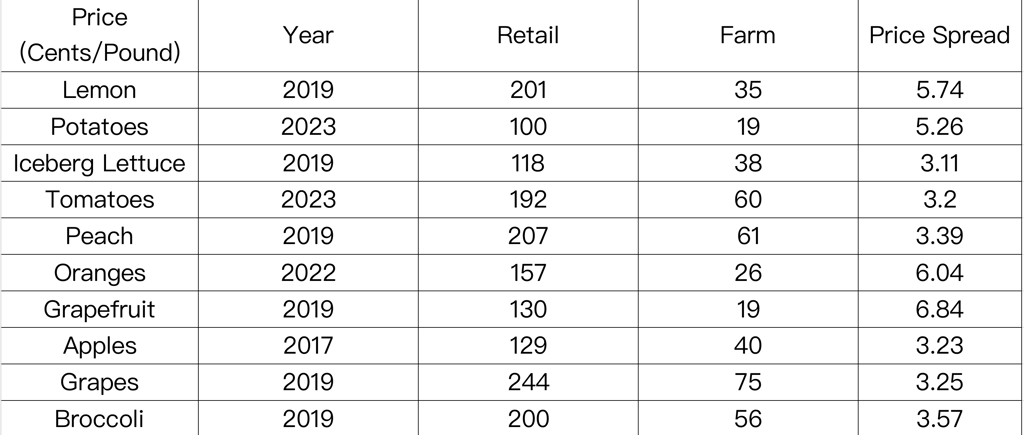


Cool Innovation significantly advances several United Nations Sustainable Development Goals (SDGs) through its innovative fresh produce preservation technologies. These technologies contribute to enhanced food security, waste reduction, promotion of sustainable practices, and provision of economic benefits.
Efficient energy use reduces overall energy consumption in refrigeration, supporting sustainable energy utilization. Cool Innovation's energy-efficient refrigeration technology reduces energy consumption by approximately 50% compared to traditional methods.
According to the Cold Chain Federation, an industrial-scale cold storage facility (around 100,000 m³) requires more than 30 kWh of energy per cubic meter per year (30 kWh/m³/yr). Applying the U.S. national average of 16.43 cents per kWh, the electricity cost would be $492,900. By using Cool Innovation's technology, users can save about $250,000 annually while keeping food fresh for extended periods.
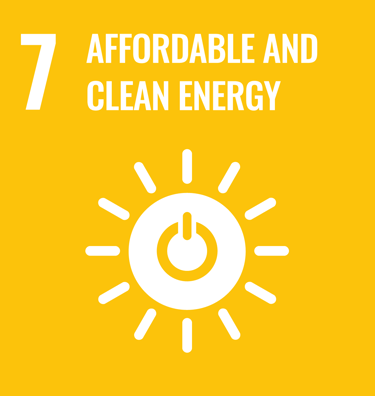

Food loss significantly impacts food availability, leading to hunger and malnutrition. According to leading food health expert of WHO, Dr Francesco Branca, “Malnutrition is a complex issue, but it is the main cause of death and disease in the world”, “1.9 billion adults are overweight or obese while 462 million are underweight. Among children, 52 million under-fives are suffering from wasting, where they have a low weight for height”.
Cool Innovation's technology extends the freshness of fruits and vegetables, ensuring a consistent supply of nutritious food. In the Philippines, the implementation of Cool Innovation's technology has reduced spoilage, increasing food availability in remote areas where transportation and storage facilities are limited.
Given the global cost of food loss is approximately $1 trillion annually, mitigating spoilage through Cool Innovation's methods could save a significant portion of this loss, potentially benefiting millions by increasing food availability and reducing prices. Improved food security could also reduce malnutrition rates, particularly among children, potentially impacting the health and well-being of over a million children in regions where Cool Innovation operates (SDG Innovators) (UNDP) (UNRIC).
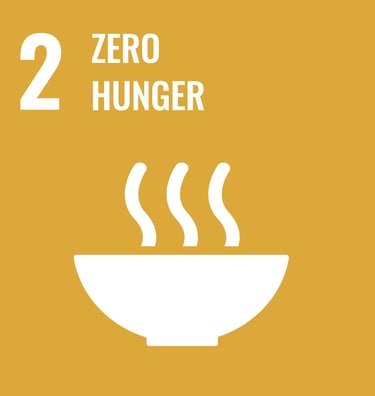

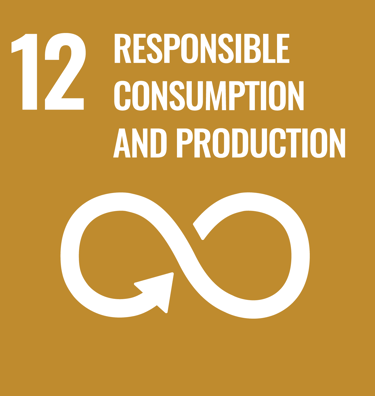

Sustainable management and efficient use of natural resources are crucial to reducing environmental impacts. Cool Innovation minimizes food waste throughout the supply chain.
With food waste accounting for economic losses of around $680 billion in industrialized countries, Cool Innovation's interventions could save billions by enhancing supply chain efficiency. Furthermore, reduced waste means lower methane emissions from decomposing organic matter, contributing to a reduction in greenhouse gases (Opportunity Desk) (UNDP).
According to research by the UK government, transporting the same cargo over the same distance by airplane generates 44 times more CO2 compared to a ship. While airplanes emit 500 grams of CO2 per metric ton of cargo per kilometer, sea transport emits 10 to 40 grams of CO2 per kilometer.
The industry has been eager to switch from air to sea transport for perishables but it was not possible until Cool Innovation’s long preservation technology. This shift could reduce millions of tons of CO2 emissions annually, significantly aiding climate action goals (Opportunity Desk) (UNDP).



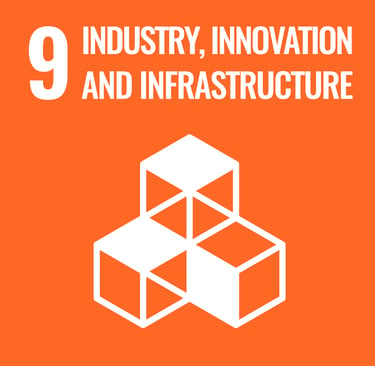
Developing resilient infrastructure and fostering innovation are key to sustainable industrialization. Cool Innovation’s advanced cold chain technology facilities enables long term preservation for fresh goods which enhances the local food distribution network’s efficiency and resilience.
Furthermore, Cool Innovation releases the pressure of perishable goods logistics. Currently, all fresh goods especially for vegetables, fruits, roots cannot be preserved for long so logistics companies cannot fully load the truck. Often time, the loading is less than 50% or sometimes only 30% to only meet the demand in a short period of time. With Cool Innovation’s cold chain infrastructure, they can fully load fresh goods to reduce the delivery frequency while ensuring the freshness. Particularly in Japan, they are facing the lack of labor in the industry and call it “Logistics Problem 2024” which started in 2000 and has not been solved.
Improved infrastructure can significantly reduce logistics costs, leading to substantial savings in transportation and distribution expenses and boosting the local economy by creating jobs. Cool Innovation’s technologies set new standards in food preservation, encouraging further innovations in the industry.


"Food deserts" refer to areas where access to fresh and nutritious food is difficult, often affecting low-income communities, even in developed countries. Residents in these areas tend to rely on processed foods and fast food, leading to increased rates of malnutrition and diet-related diseases.
Access to fresh and nutritious food is essential for preventing diet-related diseases. Cool Innovation's technology ensures the supply of fresh produce even in rural areas, contributing to improved nutrition. For example, in the Philippines, the implementation of Cool Innovation's technology has reduced food spoilage, allowing even remote areas to receive nutritious food. Applying this globally could efficiently prevent diseases such as cardiovascular issues, cystic fibrosis in children, and obesity-related cancers.
Access to a stable and nutritious supply of fresh food, supported by green and efficient logistics, is crucial for sustainable urban and rural communities. Cool Innovation enhances waste management and reduces emissions, contributing to sustainable urban living.
Additionally, Cool Innovation aids rural communities, particularly during disasters. For instance, after typhoons, island residents often face prolonged periods without access to fresh produce. Cool Innovation’s fresh food warehouses can store fruits and vegetables, ensuring that people have access to nutritious food during these critical times.
This technology not only improves urban sustainability but also supports rural resilience in disaster-prone areas.
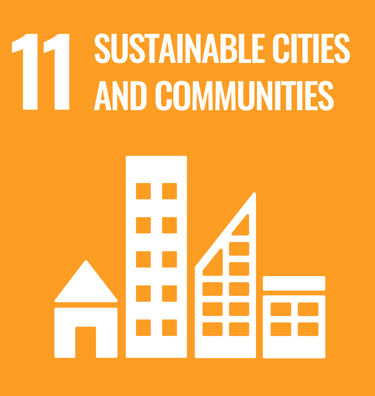

Cool Innovation’s technology ensures a stable supply of fresh produce during crises in disaster-prone regions like the Philippines and Indonesia, preventing price spikes and supporting vulnerable populations.
In Europe, it helps maintain post-harvest freshness despite abnormal weather, ensuring market stability and preventing food shortages that affect low-income communities.
In the U.S., it mitigates the impact of droughts and wildfires on produce supply, keeping food accessible and affordable during environmental crises.
In Africa, it reduces post-harvest losses, improving farmers' incomes and providing nutritious food to consumers, thereby lifting communities out of poverty and enhancing economic resilience.
By enhancing food security, stabilizing prices, and improving economic resilience, Cool Innovation significantly contributes to achieving No Poverty.



Optimizing Fresh Logistics:
The primary reasons for handling fresh produce in small batches are closely related to its nature and the realities of logistics. First, fresh produce is highly perishable and has a limited shelf life. Transporting large quantities increases the risk of unsold products and waste. Additionally, demand for fresh produce fluctuates daily and is difficult to predict, so small-batch delivery provides the flexibility to quickly respond to daily demand.
Moreover, fresh produce requires strict temperature and humidity control, making it difficult to hold excess inventory, which is why handling in small batches is common. This ensures that fresh produce is frequently delivered to maintain freshness, making small-batch delivery effective. Finally, small-batch deliveries allow for more efficient use of truck and warehouse space, reducing the risk of holding excess inventory.
In Japan, failing to improve logistics efficiency could further exacerbate the supply-demand gap due to labor shortages, with an estimated 400 million tons of transportation capacity shortfall, of which 32.5% would involve agricultural and marine products. By 2030, this shortfall is expected to reach 940 million tons (estimated by NX Comprehensive Research Institute as of November 11, 2022).
By using our fresh produce logistics infrastructure, long-term freshness can be maintained at production sites, wholesale facilities, and supermarket warehouses, allowing what used to be several small-batch shipments per week to be reduced to once a week or less. This not only multiplies the efficiency of fresh produce logistics but also maintains freshness, offering better products to consumers while enhancing the profitability of related businesses.
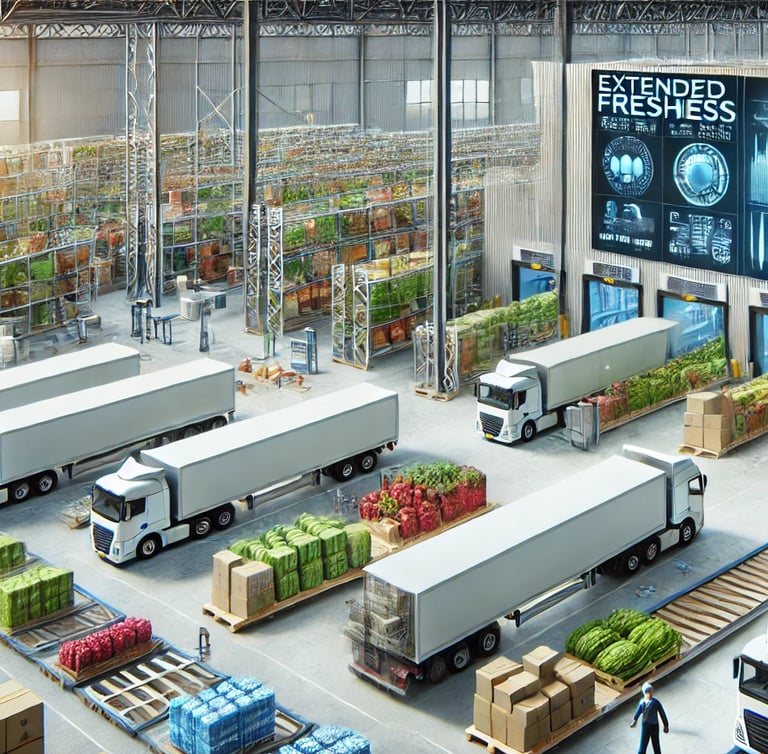

New Fresh Market via Sea Transport:
Japan's strawberries, Taiwan's pineapples, and Thailand's mangoes are well-known fruits in international fresh produce trade, but current transportation methods are mostly by air due to the lack of freshness preservation technology.
According to the Japanese Ministry of Agriculture, Forestry, and Fisheries' 2023 report on "The Situation Surrounding the Export of Fresh Produce," the export value of fresh produce in 2022 was 46.7 billion yen, with Taiwan and Hong Kong alone accounting for over 80% of the total. Considering market size, the U.S. should be a large market, but the lack of long-term freshness preservation technology has led to the development of markets closer in distance.
Air transport is quite expensive, accounting for 20% of the total cost of transporting Japan's high-priced strawberries to Thailand. When airfreighting Thai mangoes to Japan, the cost reaches 50% of the total, making it a bottleneck that prevents fresh produce traders from scaling up.
By using our long-term freshness-preserving containers, sea transport becomes feasible, reducing costs to about one-quarter of air transport. This not only increases the profitability of traders but also dramatically increases sales by lowering end prices.
Even fresh produce that could not previously cover air transport costs can now be exported overseas using our products. Therefore, the international fresh produce trade market, which has been limited by freshness preservation and costs, is expected to grow by tens or even hundreds of times in scale.
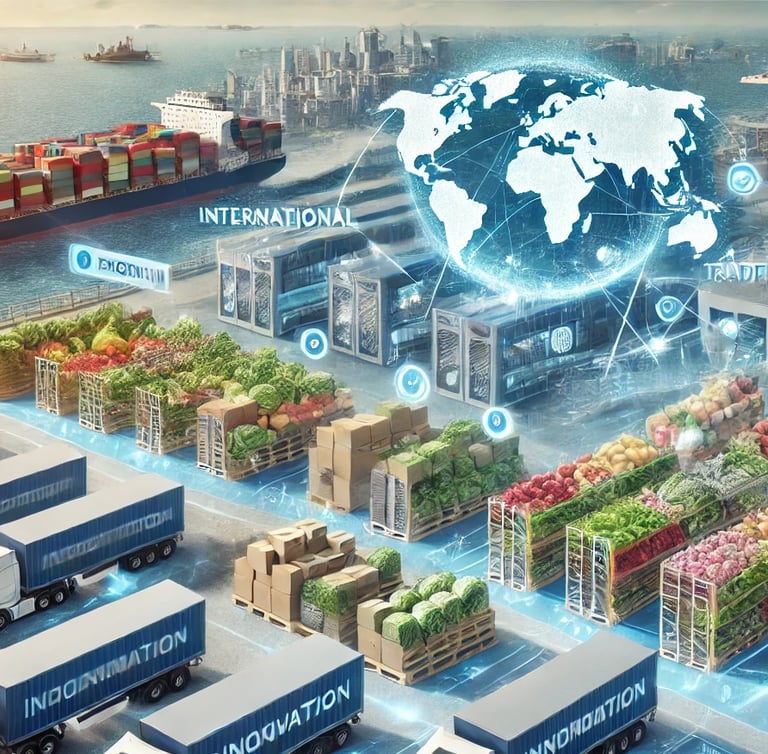

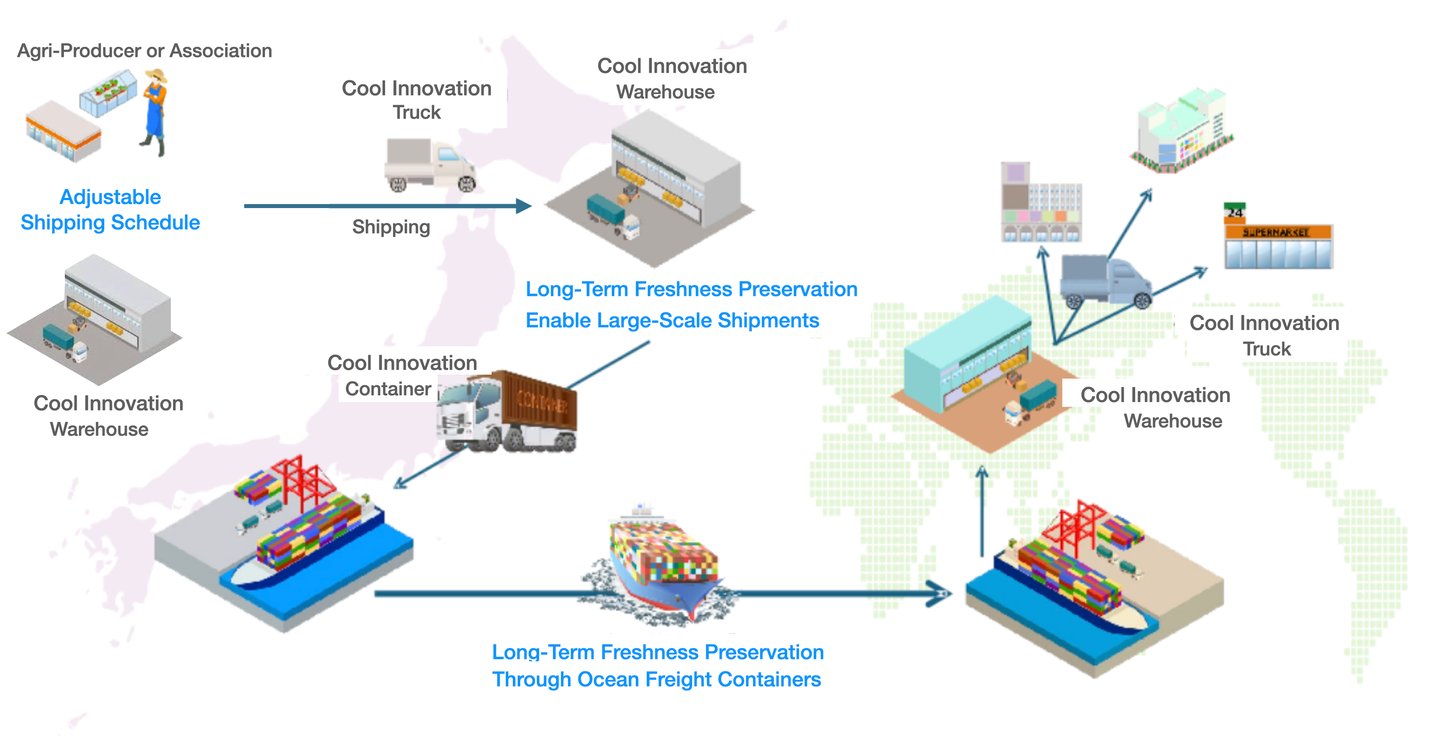


Conclusion
Cool Innovation's technology significantly surpasses traditional refrigeration techniques in efficiency and capacity, bringing innovation to the fresh produce logistics industry.
It mitigates the impact of extreme weather and environmental crises, stabilizes food supply, prevents food shortages for low-income populations, improves farmers' incomes, and provides nutritious food to consumers. This support helps alleviate poverty and enhances economic resilience.
Additionally, by maintaining the freshness of produce for extended periods, the technology improves truck loading efficiency and reduces transportation frequency. This addresses Japan's "2024 Logistics Problem" and alleviates labor shortages.
Moreover, the technology expands the international trade market for fresh produce, allowing entry into markets previously inaccessible due to high air transportation costs. Consequently, exports of fresh produce increase, fostering growth in the agriculture and food industries. It also contributes to reducing logistics costs and revitalizing local economies, promoting sustainable industrial development.
Overall, Cool Innovation's technology sets new standards in the logistics and trade markets in Japan and globally, playing a crucial role in advancing sustainable development and innovation in line with the SDGs.

Inquiries and Requests
Cool Innovation is seeking collaborative partners, academic institutions, government agencies, agricultural stakeholders, and food manufacturers to utilize, promote, and research our innovative solutions for maintaining the freshness of fruits and vegetables.
Our advanced technology not only addresses the global issue of food loss but also enables a shift from air transport to sea transport, significantly reducing costs and CO2 emissions.
With successful case studies in Japan, Thailand, and the Philippines, our technology, which guarantees reliable ROI through a subscription model, achieves 10 times* better freshness preservation compared to existing methods (*duration varies by product).
We would be delighted to work with you to reform the fresh produce supply chain and contribute to a more sustainable future.
For any questions or requests, please fill out all necessary details in the inquiry form and provide as much detail as possible about your needs. We will respond promptly and contact you regarding specific needs and solutions. Thank you.